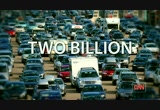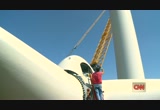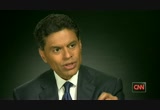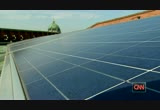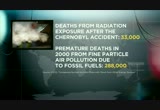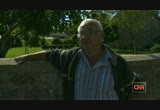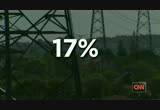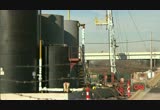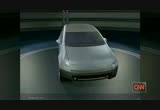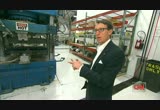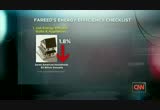tv Powering America CNN October 27, 2012 8:00pm-9:00pm PDT
8:00 pm
activist congressman john lewis joined in and went gangnam style. ♪ he's our moment of the week because he left his ego behind for a good cause. i'm don lemon. thanks for watching. have a good night. welcome to "global lessons: the gps roadmap for powering america." i'm fareed zakaria. at a recent talk at the ted conference, bill gates let us in on a secret, if he could have anything, this is what the world's richest man wants, an energy source that is cheaper than coal and has zero carbon dioxide emissions. he said this would improve the prospects for the human race more than anything he could imagine. why does gates think that? because he knows the world is going to consume a lot more energy in the years ahead. for example, in the next decade, the number of cars on the road
8:01 pm
will double from 1 billion to 2 billion. overall, we'll consume 50% more energy. why? well, americans and our suvs are partly to blame, but really, it's about the rise of the rest. the world will add 1 billion people over the next two decades. if these people in fast growing countries like china and india have dreams like the american dream, houses, cars, tvs, big macs, then, as the "new york times" columnist tom friedman says, we will need another planet. today we power our lives with fossil fuels. oil, coal and natural gas provide 80% of our energy. but do we have enough energy to keep growing at this pace? and are we harming the ecosystem in which we live? already sea levels are rising, the arctic icecaps are melting,
8:02 pm
and scientists' projections about climate change are becoming more alarming. that's why bill gates makes his wish for energy that is cheap and clean. in this hour and in a "time" magazine essay, we're going to see who's doing best at energy production around the world. we'll look at technologies of the future and best practices of today. we'll go to a country that gets 75% of its electricity from a source that emits zero carbon dioxide and we'll introduce a new energy that's cheap, cleaner than coal and right in our own backyards. but first i'll take you to a country that was almost completely dependent on energy from the middle east 40 years ago. now this nation is totally energy independent. how did they do it? let's find out.
8:03 pm
in 1973, denmark was in big trouble. the yom kippur war led to an oil embargo and the days when 99% of europe was dependent on foreign energy. so they banned driving on sundays and told people to turn off their lights. in the americas as well, the 1970s brought a sense of crisis. >> i am tonight setting a clear goal for the energy policy of the united states. >> president jimmy carter encouraged conservation and installed solar panels on the roof of the white house. but those panels eventually came down and our resolve to go green faded. meanwhile, denmark doubled down on green energy, and now, incredibly, they are completely energy independent. they were helped greatly after discovering oil and gas in the north sea. >> they looked at that crisis and they just said, never again.
8:04 pm
>> tom friedman of "the new york times," author of "that used to be us," tells the story of denmark in "hat, flat and crowded," his book about going green. what was the striking thing about denmark? >> little denmark had produced a whole set of export industries around clean, renewable energy. >> after the oil crisis, the danish government subsidized renewable energy and levied big taxes on energy use and fossil fuels. gasoline costs about $8 a gallon these days. did all of that kill economic growth? no. since 1973, denmark's economy has slightly outpaced the economies that now make up the eurozone. >> what you get is enormous innovation because all your industries produce renewable energy that can sell in their marketplace. at a decent price. once they did it for little denmark, they looked around the world and said well, we can kill it in america and we can kill it in china and that's why two of
8:05 pm
the biggest energy companies in the world for wind and biofuels are danish. >> one danish powerhouse is vestas, the builder of almost one-fifth of the world's wind turbine capacity. an employer of roughly 19,000 people worldwide. vestas produced green jobs before they were trendy. >> we learned that energy dependence is something you should take very, very seriously. >> vestsa' ceo learned that the danes get almost 30% of their electricity from the wind, more than any other developed nation. by 2020, they pledge to get half of their electricity from wind power. and by 2050, they promise to be completely fossil fuel-free. >> it's not about what is possible from a technological
8:06 pm
point of view, it's all down to leadership and determination. >> samso is a sign of what's possible. it's a sleepy island between the north sea and the baltic sea where you might see as many cows as people. but don't let the rustic setting fool you, the island is on the cutting edge of energy efficiency. all of its electricity comes from the wind and overall samso actually has a negative carbon footprint. farmers like yan are clean energy entrepreneur, owning a share of the island's wind turbines. >> the wind turbines on the sea they produce 18 million kilowatt so that's the biggest export from the island that's electricity.
8:07 pm
>> the u.s. could be a wind powerhouse, too. think of those windy prairies in the great plains. >> when i discover that these resources are not being harvested, i really get amazed because, to me, that would be like going for instance to saudi arabia and not drill for oil. >> but despite its potential, the concept of wind power isn't blowing everyone away. >> fundamentally, wind is still more expensive. >> denmark's author of "the skeptical environmentalist" says that the danes' energy prices are the highest in the world. he also points out that vestas has run into trouble, it plans to cut almost 4,000 jobs in 2012, including one-fifth of its u.s. workforce. and wind power overall, he points out, is still more expensive than the cheapest fossil fuels. >> as long as it's not competitive, i still think we should say, let's invest more in getting the next generations of wind turbines to be cheaper rather than putting up lots and lots of them that we know are inefficient right now.
8:08 pm
>> but people say the only way you get the cost curve down is deploying large amounts of existing energy for scale. >> there's definitely on argument for scale. but it's still more expensive, even after we produce lots of it. >> another big challenge, storing wind power, to use when the wind isn't blowing. in fact, all of the world's current battery capacity can store only ten minutes' worth of the world's annual energy demand, according to bill gates. one idea? take the excess energy that you can't store from the wind turbines and use it to charge the batteries for electric cars. one company called better place already has charging stations all over denmark connected to the grid where you can swap out your dead battery for a live one in just minutes. but with few electric cars on the road, that solution may take a while to catch on.
8:09 pm
denmark's wind-driven approach to energy is compelling, but wind power can be intermittent, more expensive than fossil fuels and requires a big commitment. next, we'll look at another carbon-free technology with truly remarkable potential. [ male announcer ] citi turns 200 this year. in that time there've been some good days. and some difficult ones. but, through it all, we've persevered, supporting some of the biggest ideas in modern history. so why should our anniversary matter to you? because for 200 years, we've been helping ideas move from ambition to achievement. and the next great idea could be yours. ♪
8:10 pm
8:11 pm
8:12 pm
take a look at the timer on your screen, when it reaches zero in 14.5 seconds, the sun will have emitted enough energy to power the earth for an entire day. here's another way to look at it, we could power the entire world if we covered less than 3% of the sahara desert with solar panels. the power of the sun is truly remarkable. and, surprisingly, no country is better at harnessing that power than a cloudy and cold land, germany. how did that happen? we went there to shed some light on the subject. may 25, 2012, was a historic day for germany and for the entire planet. at midday, solar panels in
8:13 pm
germany set a world record supplying one-third of the nation's electricity demand. germany is certainly not known for its sunshine, yet the nation boast's one-third of the entire world's solar capacity. >> there's no other country in the world that comes anywhere close to that level. >> dr. tom thomas knipe is the president of one of the world's leading energy companies, he says the nation's opinion about energy was changed by the soviet union's nuclear plant meltdown at chernobyl that affected many germans. >> i remember i was riding by bike as fast as i could to get home because there was a cloud coming and everyone told you not to get in the rain because there were toxic particles in it. >> in the wake of the disaster, germany's environmental movement
8:14 pm
blossomed with political groups like the green party gaining momentum. >> the green party and the major parties, the conservative and democratic took on environmental issues in their program. >> one of the key measures parliament passed was the so-called feed-in tariff. if you were a german homeowner with solar panels on your roof, you can feed your energy back into the grid and your power company is required to pay you for that energy for 20 years. was it after the feed-in tariffs were enacted that solar really took off in germany? >> yes. germans, they don't install solar systems just for saving the world. they install them because you get a nice return on investment. >> since 2000, solar installations in germany have jumped over 600-fold, providing a boon for the solar industry and even for some suburban families. families like this one who live outside of berlin. they get about $3,000 every year
8:15 pm
for the energy that his rooftop panels feed back into the grid. in seven years he'll have made enough money to cover the cost of buying the panels. after that, it's all profit. >> we made a profit, but that's not the main reason. the main reason is that we are independent in the future from all these huge energy costs. >> as solar has become more and more popular in germany, the cost has plummeted. and worldwide, it's the same story. >> over the last 20 years, with every doubling of capacity installed, the cost of solar has gone down 20%. and that has accelerated over the last two years. >> solar panels also have the advantage that you can put them where the energy is needed, say, in a new town or a remote factory, without having to lay power lines. but solar energy has its critics.
8:16 pm
>> germany is definitely leading but it's not something they should be boastful about. >> critics point out that solar energy still provides only 5% of germany's electricity and less than 1% of its total energy. remember that world record day i told you about when solar provided a third of germany's electricity? that was a very sunny day. what's more, solar subsidies are blamed for driving up energy costs for non-solar customers. >> the problem is, in order to do all of these things, you need subsidies, you need taxes. people look at that and say, this is just going to produce lots of distortions or inefficiencies. >> they're absolutely right. let's get rid of all of it, the oil depletion allowance, all the subsidies for coal and nuclear and let's let everyone compete. >> still, even in green-friendly germany, solar subsidies have caused a political backlash. the main solar subsidy is being
8:17 pm
gradually phased out, but angela merkel's government made an unscheduled cut of roughly 30% last spring. some german solar companies have run into trouble in recent years, filing for bankruptcy. >> right now we have a consolidation phase in the industry. quite frankly, there is not a single company that is making decent profits right now. >> one reason, chinese solar companies are oversupplying the market with cheaper panels helped by their own government subsidies. and even some of them are taking big losses. >> china has made solar energy so cheap, as cheap as tennis shoes and undershirts, basically. the fact is, germany is actually using so much more solar energy, but it may not be german companies that are benefitting from it. >> the potential for solar energy is huge, but it is still expensive, limited in scale and like wind, you still need some way to store it when the sun isn't shining.
8:18 pm
what about nuclear power? doesn't it solve all these problems? next, we'll visit a country that gets 75% of its electricity from nuclear, and it's never had a major accident. ♪ [ male announcer ] the way it moves. the way it cleans. everything about the oral-b power brush is simply revolutionary. oral-b power brushes oscillate, rotate and even pulsate to gently loosen and break up that sticky plaque with more brush movements
8:19 pm
8:22 pm
we've looked at wind and solar energy. what happens when the wind stops blowing and sun stops shining? one country with minimal access to natural resources turned to nuclear energy before the 1973 oil crisis awakened the world. today, france generates 75% of its electricity by splitting apart atoms and it's no coincidence that france has cheap electricity, and as you'll see, the french are apparently so thoughtful, they even recycle their nuclear waste. on august 6, 1945, the world was by little boy. that was the code name for the first ever atomic weapon dropped on hiroshima and killing in the end more than 100,000 people. out of this terrible tragedy, an industry sprung up, one that has been surrounded in mystery and conflict.
8:23 pm
>> around nuclear, there is ideology and i would say even religious and there is a feeling that there is few people which are dealing with the life of the humanity. >> the head of generation and engineering for electricity to france, the state-owned utility company, thanks to nuclear energy, france makes $3 billion every year as the world's largest net exporter of electricity. >> the only mass way of producing electricity, whatever the season, the time, the hour in the world without producing co2 is nuclear. there is no other way. >> here in a traditional french town on the normandy coast, nuclear energy seems to be a part of life. that's just the way things are, says this retired roofer.
8:24 pm
>> translator: there are people who don't like it. it doesn't bother me. it's great. without them here, we'd be dead. >> dead because the nuclear sector is the biggest employer here. this may be old france, but this town also represents the future for french nuclear power. this is the site for the epr, the european pressurized reactor. a third generation reactor that edf says will be more powerful and safer than old models. >> we included a lot of new devices which came from feedback experience from three mile island accident, chernobyl accident, even now we include new devices to answer the fukushima accident. >> but the construction of this rethought reactor is running four years behind schedule and is set to cost almost twice its
8:25 pm
original budget. and, contrary to popular opinion, it's that cost problem, not safety, that's at the heart of the nuclear issue, says "new york times" columnist tom friedman. there are a lot of people in the clean energy business who look at nuclear with suspicion. >> the only thing that is a fact is price. if you want to build a 1 gigawatt nuclear plant, it's at least a $10 billion propositio that's really why it hasn't gone ahead. that said, i don't see how we get to scale without a nuclear component in our energy mix, and i think it can be done cleanly and safely. so i am not an opponent of nuclear energy. >> the day-to-day operating costs are low, and the french have streamlined up-front costs by using just seven design models to build their entire 58 reactor fleet. >> the key of the cost in industry is standardization.
8:26 pm
the edf program has been built at half of the cost german one and a third of the cost of the japanese one. because of the industrial model. >> the industry has used several plant designs where we have started to standardize. and where we store our nuclear waste, france recycles it. >> so i'm authorized to go inside. >> this woman works for state-owned nuclear giant areva. once the spent fuel arrives here at the reprocessing plant, it is unloaded and cooled. >> the spent fuel is then cooled inside cooling bath and then put inside a basket. >> all of france's used fuel ends up in pools like this. >> what you see here are the baskets where the spent fuel is stored. in the spent fool, 96% of the material is recyclable. >> about 17% of france's electricity comes from reused nuclear fuel.
8:27 pm
before she can get to the storage facility where the non-recyclable parts of the fuel are, she passes through a radiation contamination check. >> it says that we had 0.1 microsieverts. >> having only absorbed 1/500th the amount of radiation of a transatlantic flight, jordan makes it to the storage hole. >> under my both feet here, i have the equivalent quantity of what is left after one year of a production of a nuclear power plant. >> i wish we didn't have to have nuclear. in an ideal world, i'd love to replace it with full renewables. but i worry if we shut all of this down what would happen on the price side. >> but shutting down is exactly what the new french
8:28 pm
administration has talked about doing. the socialist president francois hollande has promised to reduce france's share of nuclear from 75% to 50% by 2025. so far, only one of frances's reactors is set to be decommissioned. nuclear energy accounts for 20% of america's electricity production. if there's a future for nuclear power, as a constant carbon-free companion to renewables, it will look more like the french model and there are promising new technologies that might do much better than the french model with regard to safety, cost and waste. but they're still on the drawing board. coming up next, we'll explore what is the biggest energy revolution right now. and it's happening right here at home. we'll be right back. [ male announcer ] imagine facing the day
8:29 pm
with less chronic osteoarthritis pain. imagine living your life with less chronic low back pain. imagine you, with less pain. cymbalta can help. cymbalta is fda-approved to manage chronic musculoskeletal pain. one non-narcotic pill a day, every day, can help reduce this pain. tell your doctor right away if your mood worsens, you have unusual changes in mood or behavior or thoughts of suicide. antidepressants can increase these in children, teens, and young adults. cymbalta is not approved for children under 18. people taking maois or thioridazine or with uncontrolled glaucoma should not take cymbalta. taking it with nsaid pain relievers, aspirin, or blood thinners may increase bleeding risk. severe liver problems, some fatal, were reported. signs include abdominal pain and yellowing skin or eyes. tell your doctor about all your medicines, including those for migraine and while on cymbalta, call right away if you have high fever, confusion and stiff muscles or serious allergic skin reactions like blisters, peeling rash, hives, or mouth sores to address possible life-threatening conditions.
8:30 pm
talk about your alcohol use, liver disease and before you reduce or stop cymbalta. dizziness or fainting may occur upon standing. ask your doctor about cymbalta. imagine you with less pain. cymbalta can help. go to cymbalta.com to learn about a free trial offer. ♪ [ male announcer ] this is karen and jeremiah. they don't know it yet, but they're gonna fall in love, get married, have a couple of kids, [ children laughing ] move to the country, and live a long, happy life together where they almost never fight about money. [ dog barks ] because right after they get married, they'll find some retirement people who are paid on salary, not commission. they'll get straightforward guidance and be able to focus on other things, like each other, which isn't rocket science. it's just common sense. from td ameritrade.
8:32 pm
we've traveled the world to see how other countries have focused on wind, solar and nuclear power. currently all those forms of energy have upsides and downsides. but what if we could innovate our way to a more effective energy technology right here at home? we may already have done that. down in louisiana, off the gulf of mexico, something strange is
8:33 pm
happening. a few years ago, as american natural gas supplies were dwindling a company called cheniere energy built a facility to import liquid natural gas from other countries. now, just a few years later, it's converting the facility to export gas. so you build this terminal to import liquid natural gas. >> yes. >> a funny thing happens in the next few years. >> well, it wasn't so funny. >> it wasn't funny for the cheniere ceo because his company almost went bankrupt. what happened? the low levels of natural gas production in america suddenly gave way to a boom, thanks to shale gas. how big is the shale gas revolution in america? >> it's stupefyingly large. >> in 2000, shale gas accounted
8:34 pm
for only 2% of all natural gas. in 2012, it accounts for 32%. that's because america happens to be the saudi arabia of shale gas with big shale deposits over much of the country. and here's the kicker. when you burn natural gas to produce energy, it emits roughly half as much greenhouse gas as coal. >> natural gas is the perfect complement to wind and solar. not only does it emit half as much co2 as coal, but you can just turn it on and off when the sun goes down or the wind stops blowing to make tremendous inroads in reducing our carbon emissions. >> in fact, we have already reduced emissions. in 2011, greenhouse gas emissions in the u.s. were 9% lower than 2007 levels.
8:35 pm
one reason was that demand for transportation fuel was down, but another major cause, according to the government, was our switch from coal to natural gas. in 2000, natural gas accounted for only 22% of the electricity we get from fossil fuels. compared to 73% for coal. through july of 2012, it accounted for 46%, and coal was down to 53%. that dramatic switch didn't happen because of our suddenly greener outlook on life. a main reason it happened is because natural gas now costs about the same as coal. >> fracking shows us if we get the price below, for instance, coal, everyone will adopt it. you will get a dramatic shift. you'll get reduction in co2 emissions because it's a greener alternative and you'll get cheaper prices. >> but there are definitely some
8:36 pm
downsides to shale gas and plenty of controversy. here's how fracking works. millions of gallons of water mixed with sand and chemicals is shot down a well as deep as 10,000 feet below ground. the water hits the shale with a lot of pressure, causing it to fracture and release natural gas back up the well. >> what you do with that water afterwards is very important. can you treat it? clean it again and reuse it? do you just leave it in pools lying around? do you inject it into the ground in ways that could cause earthquakes, which is a real problem? or seep into aquifers? >> another challenge? containing gas leaks during the extraction process, especially methane, which is a potent greenhouse gas. the oscar-nominated documentary "gas lamp" portrayed how people's water supplies became flammable.
8:37 pm
many of these allegations have been contested. for example, sometimes the gas that has ended up in people's water pipes comes from wells that they drilled in their backyards, not from fracking. but the epa is working on a comprehensive study of fracking, as it should. this is an industry that needs regulation. >> i think it's very important that we get a grand bargain between the environmental community and the natural gas industry that says, we're going to do this right. it's in the huge interest of the natural gas industry because if i turn on my tap and a flame comes out or i've got natural gas coming up my toilet, i'm telling you they will shut this industry down. >> that would be a shame for our economy. shale gas is cheap energy and cheap energy fuels growth, from lowering our heating bills to cutting the costs of shipping and making things. pricewaterhousecoopers says the shale gas boom could spark a manufacturing renaissance creating 1 million manufacturing jobs by 2025.
8:38 pm
and think about how cheap natural gas could lower carbon emissions in china and india, where they are building four coal-fired power plants a week with disastrous environmental effects, not to mention the thousands of people who die because of coal mining. >> what really matters is what china and india does. they want more energy and they want it cheaper. so what we have to make sure is that we focus on innovation to make green energy sources so cheap they will switch. we have shown the way through the fracking of gas, but we still need to move further. we need to make green energy, solar panels, wind turbines, even cheaper. once they become cheaper than fossil fuels, everyone will buy them. >> once the natural gas terminal is up and running, they'll be able to move energy to china and india for a good profit and create jobs here at home. we've shown you many different
8:39 pm
approaches to energy in this hour, but we're saving the best for last. next, we'll show you what is arguably the greenest, safest, and most profitable form of energy. this is something that tree huggers and ceos are both going to love. in-wash scent boosters, here with my favorite new intern, jimmy. mmm! fresh! and it's been in the closet for 12 weeks! unbelievable! unstopables! i'll show you how! ♪ just shake them into the washer i can't believe this lasts 12 weeks! neither can they. so you're going on tour to prove it. downy unstopables. follow jimmy's unstopables tour on youtube. downy unstopables. wooohooo....hahaahahaha! oh...there you go. wooohooo....hahaahahaha! i'm gonna stand up to her! no you're not. i know.
8:40 pm
you know ronny folks who save hundreds of dollars switching to geico sure are happy. how happy are they jimmy? happier than a witch in a broom factory. get happy. get geico. fifteen minutes could save you fifteen percent or more. boring. boring. [ jack ] after lauren broke up with me, i went to the citi private pass page and decided to be...not boring. that's how i met marilyn... giada... really good. yes! [ jack ] ...and alicia. ♪ this girl is on fire [ male announcer ] use any citi® card to get the benefits of private pass. more concerts. more events. more experiences. [ jack ] hey, who's boring now? [ male announcer ] get more access with a citi card. [ crowd cheering, mouse clicks ]
8:41 pm
i just served my mother-in-law your chicken noodle soup but she loved it so much... i told her it was homemade. everyone tells a little white lie now and then. but now she wants my recipe [ clears his throat ] [ softly ] she's right behind me isn't she? [ male announcer ] progresso. you gotta taste this soup. that was me... the day i learned i had to start insulin for my type 2 diabetes. me... thinking my only option was the vial and syringe dad used. and me... discovering once-daily levemir® flexpen. flexpen® is prefilled. doesn't need refrigeration for up to 42 days. no drawing from a vial. dial the exact dose. inject by pushing a button. flexpen® is insulin delivery... my way. levemir® (insulin detemir [rdna origin] injection) is a long-acting insulin used to control high blood sugar in adults and children with diabetes and is not recommended to treat diabetic ketoacidosis.
8:42 pm
do not use levemir® if you are allergic to any of its ingredients. the most common side effect is low blood sugar, which may cause symptoms such as sweating, shakiness, confusion, and headache. severe low blood sugar can be serious and life threatening. ask your healthcare provider about alcohol use, operating machinery, or driving. other possible side effects include injection site reactions. tell your healthcare provider about all medicines you take and all of your medical conditions. get medical help right away if you experience serious allergic reactions, such as body rash, trouble with breathing, fast heartbeat, or sweating. with flexpen®... say good night to vial and syringe. ask your doctor about levemir® flexpen. covered by 90% of insurance plans, including medicare. find your co-pay at myflexpen.com. i'm don lemon. here's a look at your headlines right now. whipping up the eastern seaboard tonight, hurricane sandy, it is a category 1. and most forecast models show it hitting the coast around midnight sunday.
8:43 pm
emergency agencies have washington, d.c. to maine are bracing for high water. heavy winds and for the power to go out. hurricane sandy is causing president obama and mitt romney to rearrange their campaign schedules. president obama will be in florida on sunday away from the storm. mitt romney called off rallies in virginia. he'll campaign with running mate paul ryan in ohio instead. and this young lady is amanda rubio, the 12-year-old daughter of florida senator marco rubio, spending the night in a miami hospital after an accident today while riding in a golf cart. we're told she has a head injury but is in stable zn condition. her dad, the senator, was campaigning with mitt romney when he got the news and immediately headed to miami. those are the headline this is hour. i'm don lemon, keeping you informed, cnn, the most trusted name in news.
8:44 pm
we've explored a number of ways to create cheaper, greener energy, but experts often cite a fifth fuel as being just as important -- efficient si. what if we could get more mileage, more bang for our buck, for every kilowatt of energy we used? one man shows us how we can save energy and money, all from his banana farm. welcome to the jungle. but we're not in the tropics, we're more than 1,000 miles north in the rocky mountains of western colorado. >> we have a tropical jungle in the middle that's just hatched its 43rd banana crop. >> here, near aspen, physicist and environmentalist amory lovins curates tropical flora and fauna.
8:45 pm
this jungle is a sort of greenhouse that acts as a furnace for the 4,200-square-foot home using integrated design concepts, it lets light in, stores heat and captures seven kinds of energy. >> heat, light, hot water, hot air, photosynthesis and the pure distilled water and the energy it took to evaporate it. >> there's no heating system in the house, and yet crops sprout here even during the winter solstice. >> it's really fun to sit here while it's blizzarding outside and monitor your tropical fruit and realize you're not burning any rotted remains of primeval swamp goo. >> during the day the house runs on solar power. lovins sells back any excess to the grid. purchased wind power fuels the house at night, and fully
8:46 pm
charged batteries serve as backup in case the grid goes down. >> collecting hot water in here. >> lovins knows that most people won't build homes like his. >> runs on ambient light. >> but he insists we can start to save the earth and save money just by being a little more efficient in our energy use. >> the u.s. could get completely off oil and coal by 2050 with a 2.64% bigger economy and eliminate nuclear energy and use a third less natural gas. $5 trillion cheaper than business as usual. not counting any hidden costs like carbon emissions. >> in "reinventing fire," amory lovins and the rocky mountain institute, his self-described think and do tank, lay out a blueprint for how the u.s. can achieve that goal. and he says there is no need for government intervention because businesses would lead the effort and profit from doing it. >> we found this would require no new inventions and no act of congress because it could be led
8:47 pm
by business for profit. the $5 trillion on the table is ample inducement. >> for example, we can save money by putting our gas guzzlers on a diet. >> over the past quarter century, they've gained weight twice as fast as we have. two-thirds of the energy it takes to move a typical car is caused by its weight. >> trains, planes and automobiles burn over 13 million barrels of oil every day in the united states. and we spend over $1 billion per day buying that oil, almost half of which comes from foreign countries, some of whom are considered national security problems. >> weaning ourselves off oil saves about $4 trillion net present value in the united states alone. that money then stays at home. >> so lovins reasons, what if we wasted less fuel getting gas to the wheels?
8:48 pm
and he designed the hypercar, which could weigh about two-thirds less than a normal car and could run up to an astonishing 240 miles per gallon. it will be made of carbon fiber parts like this one. >> here is my carbon cap, a little piece of carbon fiber composite. >> he has this carbon fiber cap. you took a sledgehammer to it. why? >> i wanted to see if it could hold up to a car accident. >> "new york times" columnist tom friedman's attempts to whack, jump on and demolish the parts were unsuccessful. and lovins believes carbon fiber is durable and light enough to revolutionize the auto industry. fiberforge, a for-profit spin-off of the rocky mountain institute -- >> this is a lightweight seat frame we worked on -- >> -- is taking that bet, manufacturing the type of fiber parts that would ultimately be used in a hypercar. >> these materials absorb more
8:49 pm
energy per unit pound than aluminum or steal so your cars are not only going to be lighter but they'll be safer. >> if hypercar sounds like science fiction to you, volkswagen and bmw will start producing their versions of hypercars next year. and it's not just cars. buildings can get a lot more energy efficient, too. if america's 120 million buildings were a country, they would use more energy than every country in the world except for the united states and china. a lot of that comes from densely populated cities like new york where lovins helped retrofit the empire state building. >> we were able to get the 6,514 windows remanufactured on site into superwindows that let light through but block heat, and then combining that with better lights and office equipment and
8:55 pm
8:56 pm
energy equivalent of the labor of 2,000 humans. another is a jet plane. it uses the energy equivalent of 700,000 humans. so the first thing to admit is that we need lots of energy. the second is to realize that, for the foreseeable future, we will be dependent on fossil fuels. in 2010, the u.s. got 83% of its energy from fossil fuels. in 2035, despite great increases in efficiency, the u.s. government says we will still get 77% of our energy from fossil fuels. that leads to a few conclusions. we need more renewable energy. today renewable energy gives us 10% of our electricity. by 2035, that will rise to 16%. we should try to move towards it faster. but even if we were to succeed, we would still need to use
8:57 pm
fossil fuels for the majority of our energy needs. governments around the world, including the united states, have provided enormous help to the fossil fuel industry in many ways, from building out the infrastructure it uses to protecting our supplies of oil from the middle east. even fracking, by the way, was developed with the help of the department of energy. so it's perfectly sensible to say government should provide some support to the technologies of the future as well. that support should mainly go towards research that would lead to technological breakthroughs. but we should also help these nascent industries, wind and solar, to achieve scale, just as we helped the computer industry in the 1950s and 1960s. but having done all of that, it is clear that we will still need fossil fuels for the majority of our energy for decades to come. that means choosing among them, and when natural gas replaces
8:58 pm
coal, you end up with a win-win. it is cost competitive, and it emits half the carbon donsrbon emissions of coal. the conversation about fracking cannot take place without considering what would happen if we did not get that energy from shale gas. we would get it from coal, which is the dirtiest fossil fuel in existence. we were all expecting a technological revolution in energy now, and we got one. but not in renewables yet. rather in the extraction of hydrocarbons. it allows us to extract mountains of natural gas. fracking should be studied carefully. it needs regulation. but we should also recognize that this might be the bridge fuel to our eventual goal -- cheap energy with zero emissions. finally, there is one area where we really should all be able to agree. energy efficiency. it's a no-brainer.
8:59 pm
it saves money, and it involves no real sacrifice. when you go to a hotel in europe, chances are that, as you leave the room and take the hotel key out of its slot, the lights will go out. why can't we standardize that practice everywhere? an energy revolution would be great for the environment, but it would also be great for economic growth. energy permeates every aspect of our lives, even more so than something like information technology. and you can see what a huge impact the information revolution has had on economic growth. an energy revolution would be the next big thing we've all been looking for. you can read more of my thoughts in a "time" magazine essay. thanks for tuning in to this gps special. you can catch my regular show on sundays 10:00 a.m. and 1:00 p.m. eastern. international viewers can
76 Views
Uploaded by TV Archive on

 Live Music Archive
Live Music Archive Librivox Free Audio
Librivox Free Audio Metropolitan Museum
Metropolitan Museum Cleveland Museum of Art
Cleveland Museum of Art Internet Arcade
Internet Arcade Console Living Room
Console Living Room Books to Borrow
Books to Borrow Open Library
Open Library TV News
TV News Understanding 9/11
Understanding 9/11
